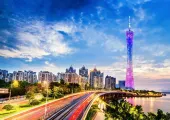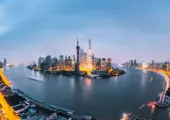2024 Chengdu Travel Guide - Best Things to do in Chengdu
Catalogue
- 1. First time to Chengdu, China
- 2. Chengdu Transportation: by Flight
- 3. Chengdu Transportation: by Train, Bus, Metro, Taxi
- 4. Best Time to Visit Chengdu - Chengdu Weather and Climate
- 5. Top 3 Things to Do in Chengdu
- 6. Chengdu Food and Restaurant Guide
- 7. Shopping in Chengdu: What and Where to Buy
- 8. Local Customs in Chengdu
Show More
What comes to mind when you think of Chengdu, China? Cuddly pandas or spicy Sichuan peppercorns? Chengdu is in fact a mega provincial capital of Sichuan Province and an economic powerhouse of southwestern China. Moreover, the city’s abundance of cultural and historical sights, together with its laidback lifestyle, make Chengdu one of the most attractive and livable large cities too.
Known in China as the "Land of Milk and Honey", Chengdu is blessed with fertile land and plenty of water. Located in central Sichuan, it is one of the country's leading rice and wheat-growing regions. Historically, Chengdu was first settled 2400 years ago, through the centuries it transformed itself into the political and cultural center of southwest China. On top of the economic significance, Chengdu also has a long history of scholarly accomplishments, with some of China's most crucial historical literature coming from there. Today the city is still a highly academic city with numerous top-rated universities and scientific research centers.

With a total population of over 16 million, around 9 million reside in the Chengdu metro area. There are 11 urban districts and Qingyang District is considered as the city center with attractions like Whenshu Yuan Temple and Tianfu Square. The neighboring Wuhou District is a mix of historic sites and busy commercial centers like Jinli Old Street and Temple.
From ancient temples to stunning natural wonders, mesmerizing folk performances to addictive culinary creations, Chengdu is one of China’s top ten tourist destinations. There are so many breathtaking scenic spots on offer, it will take a few days to just tick off the top sites. For visitors looking for those unforgettable experiences, consider drinking tea with locals at People’s Park, hunt for souvenirs at Jinli Old Street, be entertained by Sichuan opera, test your spice tolerance with Chengdu Hot Pot, and last not least, feed a panda in the Giant Panda Base, etc.
Chengdu is the economic and transportation hub of the region, so currently there are two major airports serving the city - Chengdu Shuangliu International Airport and Chengdu Tianfu International Airport. Convenient airport to downtown transfer options are available at both locations, such as airport shuttle, the metro, and taxis. Getting around town is also simple and convenient, as there are 12 metro lines to take you around town and stations have bilingual signs, maps, and ticket machines. Going between tourist attractions, sightseeing buses offer easy transportation.
When you are visiting a destination for the first time, there are so many things that can make or break a trip, including the season you visit. The best times for Chengdu are Spring and Fall as the weather is most pleasant with limited rainfall. If you are visiting in Summer, it can be rather hot with regular rainfall, plus it is a peak tourist season hence it can be very crowded.
Choosing the right accommodation is not always easy for a first-time visitor, check out these popular areas for your consideration. Staying in Chengdu city center (e.g. Tianfu Square) will surround you with top sites like Wide and Narrow Alley and Whenshu Yuan Temple.
For history buffs and luxury travelers, Wuhou District offers Jinli Old Street, Wuhou Temple as well as many modern malls, restaurants, and premier hotels.
Navigating a new city using public transports can be challenging, here are some useful tips and general practices. Traveling on the Chengdu Metro, signage, information, and ticket machine are in English and Chinese. When using the automated ticket machine, only use 1 RMB coin and 5-20 RMB notes. Remember to download the most up-to-date Metro map when traveling as new lines and stations are opening regularly.
For first-time foodies to the city, Chengdu is the best place for authentic Sichuan cuisine which is famed for its spicy and numbing tastes. See if you can handle local favorites like Cold Chicken in Chili Oil, Dan Dan Noodle, and Sichuan Hot Pot. Want to bring home some souvenirs? Chengdu is full of high-end retail centers (e.g. New Century Global Center) and lively street markets (e.g. Jinli Old Street) where visitors pick up local products like Chengdu silk brocade, Giant Panda products, and Chengdu hotpot seasonings.
As a major gateway to southwest China, Chengdu is the economic and transportation hub of the region. With millions of tourists visiting the city each year, there are now two large-size international airports serving Chengdu and its surrounding areas. First is the well-established Chengdu Shuangliu International Airport (CTU), located about 16 kilometers (10 miles) from the city center. It has flights to more than 220 domestic and 130 international destinations.
Travel between Shuangliu airport & downtown Chengdu couldn’t be easier. The Airport Shuttle is a budget-friendly option with 6 lines (3 regular and 3 night-times) connecting the airport to city locations such as Chengdu North and East Railway Stations, Wuhou Temple, and Tianfu Square. Fares start at 10 RMB. Alternatively, the Metro is also available via Metro Line 10 at both T1 & T2. There are detailed English signs at the airport to direct you to the airport metro station. Fares cost 4 RMB per person. For the fastest option, visitors can pick up a taxi from official taxi stands, outside T1’s Gate No.2 of Arrivals Hall and outside T2’s Gate No.4 and 5 of Arrivals Hall. Traffic permitting, a one-way trip to downtown should cost about 120 yuan.
Since June 2021, a brand new airport has opened in Chengdu - Chengdu Tianfu International Airport (TFU). Comparatively farther than CTU, it is 51 kilometers (32 miles) southeast of the city center. It is a major base from Air China and has two terminals also. For transfer options, currently, Metro Line 18 will take passengers from TFU to Chengdu South Railway Station, and from there you can change to Metro Line 1 and Line 7 for many popular downtown sites. Airport Shuttle and taxi options are also available.
With a developed transportation network, visitors can effortlessly travel around Chengdu’s many popular attractions with options like city buses, taxis, and the metro, etc.
At present, there are around 12 metro lines in operation, and additional lines are planned for the future. Worried about the language? Stations have bilingual signs, maps, and ticket machines. With plans to open more lines, it is recommended to download the most up-to-date Metro map when traveling. Fare starts at 2 RMB and will increase with distance traveled. If you plan to travel frequently by metro or bus, it’s worth buying a rechargeable Tianfu Tong Ka for discounted prices (kiosks can be found at the airport and major metro stations).
Visitors can also use both public city buses and sightseeing buses to explore Chengdu. While city buses reach all corners of the city, navigate it can be difficult for non-Chinese travelers, even when stops are marked in Chinese and English. If you are only going from one attraction to the next, sightseeing buses may be more convenient and cost-effective. Tickets to destinations are located near many tourist sites like Tianfu Square, Wide and Narrow Alley, and Wuhou Temple. Fares vary greatly depending on your destination and the type of ticket.
Other ways to get around town include flagging down an official taxi with fares starting at 8-12 RMB depending on the car model. It is worth noting that it is common practice for taxi drivers to not use the taximeter when departing from railway stations or long-distance bus stations. In this case, negotiate a flat rate before setting off.
Chengdu has a subtropical monsoon climate which means four distinct seasons with hot and humid summers, and cold and damp winters. The best times to travel to Chengdu are Spring (March to June) and Fall (September to November). In Spring, the city comes alive with refreshing spring colors. September to November has the most comfortable temperatures and no rain showers. While Summer (July and August) is the peak tourist season but expect regular rainfall and an average high temperature of 30 °C (85 °F). Winter in Chengdu is between December and February, the average low temperature is 2 °C (36 °F) with the coldest month being January. This is a low season for the city as the weather tends to be cold and damp, with some rainfall.
Chengdu has a subtropical monsoon climate which means four distinct seasons with hot and humid summers, and cold and damp winters. The best times to travel to Chengdu are Spring (March to June) and Fall (September to November). In Spring, the city comes alive with refreshing spring colors. September to November has the most comfortable temperatures and no rain showers. While Summer (July and August) is the peak tourist season but expect regular rainfall and an average high temperature of 30 °C (85 °F). Winter in Chengdu is between December and February, the average low temperature is 2 °C (36 °F) with the coldest month being January. This is a low season for the city as the weather tends to be cold and damp, with some rainfall.
Chengdu is a city with rich cultural experiences in the city and plentiful natural sceneries nearby. With so many well-deserving attractions to choose from, here are three top picks that should not be missed.
First on most people’s must-see list has got to be the giant pandas. Located just 10 km (6 miles) from downtown, the world-famous Research Base of Giant Panda Breeding (or Chengdu Panda Base) has been rescuing and breeding the endangered giant panda since 1987. Here visitors can observe the giant pandas in their natural habitat and learn about this fascinating animal at the on-site museum.
Next up is the historic Wenshu Monastery (Manjushri Monastery) which was built in 1691. It stands on the ruins of one of the oldest monasteries in the rule of the Southern Dynasties. Architecture buffs will appreciate the traditional Chinese-style buildings on the complex including the Hall of Shuofa Tang - home to the ten Buddhist guardian god’s statues, the Thousand Buddha Pagoda, and the Wenshu Monastery Library.
Chengdu is surrounded by numerous stunning day-trip locations and one visit-worthy place is the magnificent Leshan Giant Buddha. This famous colossal sculpture is 71 meters (233 feet) in height and is the largest sculpture of Buddha in the world. This site attracts millions of visitors and pilgrims every year from far and wide. Situated about 162 kilometers (100 miles) from Chengdu, visitors can easily reach this site via the bullet train, bus, or with a tour group. By train, first take the subway to Tianfu Square and then to Chengdu East Railway Station for trains to Leshan Railway Station. From there, take a local public bus like Bus 3 or a taxi to the Giant Buddha Scenic Area.
Known for its spicy, numbing, and umami-tasting natures, the food in Chengdu belongs to Sichuan cuisine - one of the eight culinary cuisines of China. The food is so unique and legendary that UNESCO honored it as its first-ever City of Gastronomy.
Visitors wanting to sample these mouth washing Chengdu dishes should first try the fiery Sichuan Hot Pot. While the hot pot is a national favorite, the version served in Chengdu is numbingly spicy with sliced meat, offal, vegetables, and most importantly, Sichuan peppercorns. Both Chengdu Huangcheng Laoma and Lao Ma Tou are good choices for this addictive local good-eat.
If the local spice level suits you just fine, then try the Cold Chicken in Chili Oil, a popular cold appetizer dish that perfectly combines spicy with mala or numbing flavor of Sichuan cuisine. This simply boiled chicken dish has an intense sauce that tastes hot, sweet, savory, and sour.
For anyone who prefers non-spicy food, Twice Cooked Pork is the dish for you. Also a Sichuan delicacy where pork pieces are cooked in two different ways, first by simmering (then cooled), and second by stir-frying (with various vegetables). You can try this delectable dish at Yu’s Family Kitchen and Chen Mapo Tofu Restaurant.

Chengdu is not only famous for its delicious cuisine and world-class attractions, but it is also a paradise for shopping lovers. The megacity has a wide range of souvenirs, produce, and memorabilia to satisfy your every need. By far the most popular buy for tourists is Chengdu brocade (silk). These delicate embroideries are used to embellish quit covers, clothing, and tapestries. Other items that also make great gifts are Giant Panda products, Tibetan-style ornaments, tea and tea sets, and Chengdu hotpot seasonings.
Where are the best places to buy these local goodies? If visitors are interested in getting Tibetan-style ornaments and handicrafts, one should head to the road on the opposite side of Wuhou Temple. Tourists can find top-quality Chengdu Brocade at Hongqi store or Shujiang Jinyuan near the Du Fu Thatched Cottage.
In terms of popular shopping areas in Chengdu, first up is Chunxi Road - a famous pedestrian street with many department stores, shopping malls, and supermarkets. Jinli Old Street near Wuhou Temple is one of the oldest shopping streets not just in Chengdu but in Sichuan Province. This is a great place for shopping, local food, folk music, and performance, etc.
Compared to other urban areas of similar size, Chengdu is considered generally safe. But visitors should stay vigilant as petty crimes do occur regularly, especially on public transportations and crowded tourist spots. In the northern sector of the city (near the train station) and during late night hours, the rate of crime is higher. For emergencies, dial 110 for police (or find a patrolling officer in tourist destinations) and 120 for ambulance services.
The official currency used in China is Renminbi (RMB) which is also known as Yuan. While tipping is not customary in China, it is acceptable to leave a gratuity for guides, drivers, and hotel porters.
Trending Travelogues
Popular Trip Moments
Popular Travel Types
Popular Attractions
Popular Ranked Lists
Popular Destinations
Recommended Attractions at Popular Destinations
About











Site Operator: Trip.com Travel Singapore Pte. Ltd.









